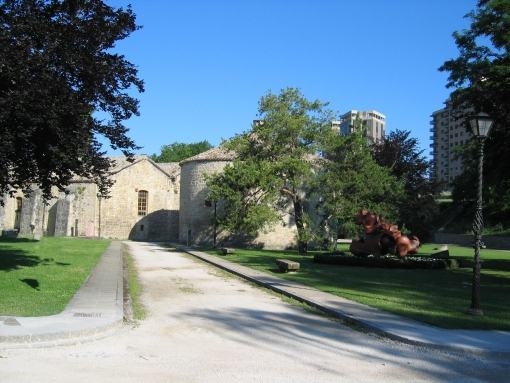Indirect-response model for the analysis of concentration-effect relationships in clinical trials where response variables are scores
V. Piotrovsky
J&J Pharmaceutical Research & Development, Beerse, Belgium
Aim: Clinical effectiveness of many drugs can only be assessed in terms of scores quantifying the patient status (symptoms’ intensity). Generally speaking scores are ordered categorical variables, however, when the number of categories is big enough they can be considered as continuous, though they are constrained and never exceed lower and upper limits. In the example presented in this study the score R is between 0 and 70, and the higher is R the stronger is the disease severity. The desirable drug effect is thus the reduction of R. The aim of the study was to apply a general indirect response model for clinical efficacy data [Piotrovsky V. Drug Efficacy Analysis as an Exercise in Dynamic (Indirect-Response) Population PK-PD Modeling. 11th PAGE Meeting, Paris, France, 2002] to actual data collected in two trials.
Methods: The model expresses the rate of patient status change as a balance between the rate of deterioration (rD) and amelioration (rA):
dR/dt = rD – rA.
Initial conditions are: R(0) = R0 (“baseline”). rA is assumed proportional to the current value of R, and the proportionality coefficient K (equilibration rate constant) indicates how fast the system stabilizes after a perturbation, e.g., treatment initiation:
dR/dt = rD – K*R (1)
It is assumed that the drug affects rD, namely reduces it. For convenience, rD is replaced by a parameter having the properties of scores. Since R is restricted dR/dt must tend towards zero when t -> Inf. The asymptotic value of R at t -> Inf, RP, will replace R in Eq 1: rD – K*RP = 0. rD can then be expressed via RP: rD = K*RP. Substituting this into Eq 1 gives:
dR/dt = K*(RP – R) (2)
Eq. 2 describes disease progression, and RP is an ultimate score: if RP>R0 the patient deteriorates otherwise he/she remains stable or spontaneously improves. K controls the rate of changes. The drug should thus reduce RP, and if the effect significantly exceeds that of placebo the drug is efficacious. RP becomes thus a composite parameter incorporating various (fixed and random) effects. To keep it within the boundaries these effects are considered in the logit domain:
RP = 70*exp(logit(RP))/(1 + exp(logit(RP))),
and their contribution is additive:
logit(RP) = logit(R0) + DP + EP + ED.
DP, EP and ED stand for disease progression, placebo and drug effects, respectively. According to this implementation, the disease progression is a shift in the logit domain. Graphical analysis of mean score versus time show that after initial decrease due to drug/placebo effect R increases, and this may indicate the gradual weakening of one or both effects, in other words, long-term “tolerance”. It is implemented as an exponential decay of EP and ED governed by a rate constant KT. “Tolerance” makes EP estimable: otherwise it cannot be separated from DP.
The steady-state plasma concentration of the drug, Css, was used as a predictor of the drug effect though an Emax model:
ED = Emax*Css/(C50 + Css)
where Emax is a maximal drug effect in a logit domain, and C50 is a plasma concentration corresponding to the half-maximal effect. A linear concentration-effect model was also tested, but was found to be inferior. Graphical analysis showed almost no differences in exposure between centers.
The fixed effect of the study center on R0 was included as it was evident from the raw data. Other effects were also tested using the likelihood ratio test (see below). The model incorporated individual random effects on K, R0 and DP. The normal distribution and constant variance model was postulated for logit(R0) and DP. In the case of K the exponential variance model was assumed. All random effects were correlated except those on K and DP. The constant variance residual error model was used.
The model was fitted using NONMEM V software and the first-order conditional estimation method.
Results and discussion: We present an example of the concentration-response analysis of efficacy data collected in two trials conducted in different centers following similar double-blind parallel-group designs. In Center 1, patients were randomized into placebo or active treatment groups with the daily drug dose 8 mg during the first 4 weeks. Then it either increased to 16 or 24 mg or remains the same (thus 3 active treatment groups). In Center 2, after initial 8 mg daily for 4 weeks patients received either 16 or 24 mg (2 active treatment groups). The overall duration of the studies was 22 weeks. Clinical status was assessed at randomization and after 4, 12 and 22 weeks of treatment. Plasma samples were collected at each visit. Standard biostatistical analysis based on changes from baseline demonstrated significant drug effect at 22 weeks compared to placebo in Center 1, but no in Center 2.
According to the model the only center effects were on K (0.00370 and 0.00268 1/day in Center 1 and 2, respectively) and C50 (58.9 and 235 ng/mL) and R0 (27.8 and 23.9). No difference in terms of Emax was found. It was low compared to the placebo effect: -0.975 and -4.85, respectively. The disease progression contribution (DP) was 4.56. In total, EP+Emax=-5.825 fully compensates the worsening caused by DP, however, due to “tolerance” these effects diminish, and after some time disease progression became dominating again. Apparently the big diference in C50 between two centers plays a major role and finally explains why the trial in Center 2 fails to show efficacy.
Conclusion: The model presents a platform for analysis and simulation of clinical efficacy/safety trials where endpoints are scores. It is still under development, in particular aimed to optimize random effects that is important for simulation to better design studies (determine an optimal trial duration, number of patients to be recruited, etc.). Another potential application can be prediction of clinical effects from in vitro (e.g. receptor binding) and preclinical studies.
